Low Heat Availability Could Limit the Potential Spread of the Emerald Ash Borer to Northern Europe (Prognosis Based on Growing Degree Days per Year)
Abstract
:Simple Summary
Abstract
1. Introduction
2. Materials and Methods
2.1. Occurrences of Agrilus planipennis
2.2. Calculation of Annual Growing Degree Days
- The daily mean temperature was calculated for each day as a mean of the temperatures at 00:00, 02:00, 04:00, 06:00, 08:00, 10:00, 12:00, 14:00, 16:00, 18:00, 20:00 and 22:00 UTC.
- Then the growing degree days base 10 °C from 1 January to 31 December were calculated for each year since 2003 to 2020 (AGDD10 in each particular year).
- Then the mean AGDD10 per year in 2003–2020 was calculated.
2.3. Analysis and Visualisation of Results
3. Results
3.1. Heat Availability in the Regions Currently Occupied by A. planipennis
3.2. Heat Availability in Europe
3.2.1. General Distribution of Heat Availability
3.2.2. The Distribution of Heat Availability within the Range of Fraxinus Excelsior in Scandinavia
3.2.3. The Distribution of Heat Availability within the Range of Fraxinus Excelsior in British Isles
4. Discussion
4.1. Heat Availability as a Limiting Factor of A. planipennis Range
4.2. Comparison of Low Heat Availability and Minimum Winter Temperature as Limiting Factors of A. planipennis Potential Distribution
4.3. Perspectives for Future Researches
5. Conclusions
- Minimum AGDD10 recorded in the localities of A. planipennis in the three continents are almost the same: 714° in Asia, 705° in North America, and in 711° Europe. Agrilus plenipennis has been never recorded in the regions with AGDD10 below 700°.
- In the majority of Europe, AGDD10 is more than 700°. Therefore, low heat availability would probably not limit the spread of A. planipennis in most of European countries.
- Heat availability in most regions of Norway, Sweden, Finland, and Ireland and in the northern half of Great Britain is less than 700°. If the phenotypic plasticity would not allow the pest to overcome this threshold, A. planipennis would potentially not establish in these regions. Therefore, Fraxinus excelsior could potentially escape from A. planipennis in these regions.
Supplementary Materials
Author Contributions
Funding
Institutional Review Board Statement
Data Availability Statement
Acknowledgments
Conflicts of Interest
References
- Emerald Ash Borer Informative Network. Available online: http://www.emeraldashborer.info/ (accessed on 6 October 2021).
- Volkovitsh, M.G.; Bieńkowski, A.O.; Orlova-Bienkowskaja, M.J. Emerald Ash Borer Approaches the Borders of the European Union and Kazakhstan and Is Confirmed to Infest European Ash. Forests 2021, 12, 691. [Google Scholar] [CrossRef]
- Orlova–Bienkowskaja, M.J.; Volkovitsh, M.G. Are native ranges of the most destructive invasive pests well known? A case study of the native range of the emerald ash borer, Agrilus planipennis (Coleoptera: Buprestidae). Biol. Invasions 2018, 20, 1275–1286. [Google Scholar] [CrossRef]
- Haack, R.A.; Jendek, E.; Liu, H.; Marchant, K.R.; Petrice, T.R.; Poland, T.M.; Ye, H. The Emerald Ash Borer: A new exotic pest in North America. Newsl. Mich. Entomol. Soc. 2002, 47, 1–5. [Google Scholar]
- Izhevskii, S.S. Threatening Findings of the Emerald ash Borer Agrilus planipennis in the Moscow Region. Available online: http://www.zin.ru/Animalia/Coleoptera/rus/agrplaiz.htm (accessed on 23 October 2021).
- Commission Delegated Regulation (EU) 2019/1702 of 1 August 2019 Supplementing Regulation (EU) 2016/2031 of the European Parliament and of the Council by Establishing the List of Priority Pests. OJ L 260:8–10. Available online: http://data.europa.eu/eli/reg_del/2019/1702/oj (accessed on 23 October 2021).
- Schans, J.; Schrader, G.; Delbianco, A.; Graziosi, I.; Vos, S. Pest survey card on Agrilus planipennis. EFSA Support. Publ. 2020, 17, 1945E. [Google Scholar] [CrossRef]
- Orlova-Bienkowskaja, M.J.; Bieńkowski, A.O. Modeling long-distance dispersal of emerald ash borer in European Russia and prognosis of spread of this pest to neighboring countries within next 5 years. Ecol. Evol. 2018, 8, 9295–9304. [Google Scholar] [CrossRef] [PubMed]
- Musolin, D.L.; Selikhovkin, A.V.; Peregudova, E.Y.; Popovichev, B.G.; Mandelshtam, M.Y.; Baranchikov, Y.N.; Vasaitis, R. North-Westward expansion of the invasive range of emerald ash borer, Agrilus planipennis Fairmaire (Coleoptera: Buprestidae) towards the EU: From Moscow to Saint Petersburg. Forests 2021, 12, 502. [Google Scholar] [CrossRef]
- Majorov, S.R.; Bochkin, V.D.; Nasimovich, Y.A.; Shcherbakov, A.V. Alien Flora of Moscow and Moscow Region; KMK Publishing House: Moscow, Russia, 2012. [Google Scholar]
- Baranchikov, Y.N.; Seraya, L.G.; Grinash, M.N. All European ash Species are Susceptible to Emerald ash Borer Agrilus planipennis Fairmaire (Coleoptera: Buprestidae)–A Far Eastern Invader. Sib. J. For. Sci. 2014, 6, 80–85. Available online: https://xn--80abmehbaibgnewcmzjeef0c.xn--p1ai/upload/iblock/4be/4becfc1c0c3b3e232f28bd64691d9fac.pdf (accessed on 23 October 2021). (In Russian).
- Dang, Y.Q.; Zhang, Y.L.; Wang, X.Y.; Xin, B.; Quinn, N.F.; Duan, J.J. Retrospective analysis of factors affecting the distribution of an invasive wood-boring insect using native range data: The importance of host plants. J. Pest Sci. 2021, 94, 981–990. [Google Scholar] [CrossRef]
- Valenta, V.; Moser, D.; Kuttner, M.; Peterseil, J.; Essl, F. A high-resolution map of emerald ash borer invasion risk for southern central Europe. Forests 2015, 6, 3075–3086. [Google Scholar] [CrossRef] [Green Version]
- Flø, D.; Krokene, P.; Økland, B. Invasion potential of Agrilus planipennis and other Agrilus beetles in Europe: Import pathways of deciduous wood chips and MaxEnt analyses of potential distribution areas. EPPO Bull. 2015, 45, 259–268. [Google Scholar] [CrossRef]
- Orlova-Bienkowskaja, M.J.; Bieńkowski, A.O. Minimum winter temperature as a limiting factor of the potential spread of Agrilus planipennis, an alien pest of ash trees, in Europe. Insects 2020, 11, 258. [Google Scholar] [CrossRef] [PubMed]
- Bale, J.S. Insects and low temperatures: From molecular biology to distributions and abundance. Philos. Trans. R. Soc. Lond. B Biol. Sci. 2002, 357, 849–862. [Google Scholar] [CrossRef] [PubMed] [Green Version]
- Reed, K.; Denman, S.; Leather, S.R.; Forster, J.; Inward, D.J. The lifecycle of Agrilus biguttatus: The role of temperature in its development and distribution, and implications for Acute Oak Decline. Agric. For. Entomol. 2018, 20, 334–346. [Google Scholar] [CrossRef] [Green Version]
- Afonin, A.N.; Musolin, D.L.; Egorov, A.A.; Selikhovkin, A.V. Possibilities of further range expansion of the emerald ash borer Agrilus planipennis (Coleoptera: Buprestidae) in the North-West of European Russia: What factors will limit the invasive range? In Proceedings of the Arctic Congress, Saint Petersburg, Russia, 12–16 September 2016; Abstract Book. Moilanen, O., Ed.; University of the Arctic/University of Oulu: Oulu, Finland, 2016; p. 100. [Google Scholar]
- Webb, C.R.; Mona, T.; Gilligan, C.A. Predicting the potential for spread of emerald ash borer (Agrilus planipennis) in Great Britain: What can we learn from other affected areas? Plants People Planet 2021, 3, 402–413. [Google Scholar] [CrossRef]
- Orlova–Bienkowskaja, M.J.; Drogvalenko, A.N.; Zabaluev, I.A.; Sazhnev, A.S.; Peregudova, E.Y.; Mazurov, S.G.; Komarov, E.V.; Struchaev, V.V.; Martynov, V.V.; Nikulina, T.V. Current range of Agrilus planipennis Fairmaire, an alien pest of ash trees, in European Russia and Ukraine. Ann. For. Sci. 2020, 77, 29. [Google Scholar] [CrossRef]
- GBIF.org GBIF Occurrence Download: Agrilus planipennis, Canada and the USA. 23 October 2021. Available online: https://doi.org/10.15468/dl.8ab2yd (accessed on 23 October 2021).
- Copernicus Climate Change Service (C3S): C3S ERA5-Land Reanalysis. Copernicus Climate Change Service. Available online: https://cds.climate.copernicus.eu/cdsapp#!/home (accessed on 23 October 2021).
- Orlova-Bienkowskaja, M.J.; Bieńkowski, A.O. The life cycle of the emerald ash borer Agrilus planipennis in European Russia and comparisons with its life cycles in Asia and North America. Agric. For. Entomol. 2016, 18, 182–188. [Google Scholar] [CrossRef]
- Brown-Rytlewski, D.; Wilson, M.A. Tracking the emergence of emerald ash borer adults. In Emerald ash Borer Research and Technology Development Meeting; Mastro, V., Reardon, R., Eds.; 2004 USDA Forest Service Publication FHTET-2004-15; USDA Forest Service: Washington, DC, USA, 2004; pp. 13–14. [Google Scholar]
- Hijmans, R.J.; Guarino, L.; Cruz, M.; Rojas, E. Computer tools for spatial analysis of plant genetic resources data: 1. DIVA-GIS. Plant. Gen. Res. Newsl. 2001, 127, 15–19. [Google Scholar]
- Caudullo, G.; Welk, E.; San-Miguel-Ayanz, J. Chorological maps for the main European woody species. Data Br. 2017, 12, 662–666. [Google Scholar] [CrossRef] [PubMed]
- DIVA GIS Free Spatial Data. Available online: https://www.diva-gis.org/Data (accessed on 6 October 2021).
- Yurchenko, G.I.; Turova, G.I.; Kuzmin, E.A. To distribution and ecology of emerald ash borer (Agrilus planipennis Fairmaire) in the Russian Far East. AI Kurentsov’s Ann. Meml. Meet. 2007, 18, 94–98. (In Russian) [Google Scholar]
- GBIF.org (17 October 2021) GBIF Occurrence Download: Fraxinus mandshurica. Available online: https://doi.org/10.15468/dl.fcx7xc (accessed on 23 October 2021).
- GBIF.org (12 October 2021) GBIF Occurrence Download: Fraxinus excelsior, Norway. Available online: https://doi.org/10.15468/dl.y2yent (accessed on 23 October 2021).
- GBIF.org (12 October 2021) GBIF Occurrence Download: Fraxinus excelsior, Sweden. Available online: https://doi.org/10.15468/dl.wvqynz (accessed on 23 October 2021).
- GBIF.org (12 October 2021) GBIF Occurrence Download: Fraxinus excelsior, Finland. Available online: https://doi.org/10.15468/dl.8vq3wa (accessed on 23 October 2021).
- GBIF.org (13 October 2021) GBIF Occurrence Download Fraxinus excelsior, Ireland. Available online: https://doi.org/10.15468/dl.utx369 (accessed on 23 October 2021).
- GBIF.org (13 October 2021) GBIF Occurrence Download Fraxinus excelsior, Great Britain 1. Available online: https://doi.org/10.15468/dl.9nzaj9 (accessed on 23 October 2021).
- GBIF.org (13 October 2021) GBIF Occurrence Download Fraxinus excelsior, Great Britain 2. Available online: https://doi.org/10.15468/dl.gxqfja (accessed on 23 October 2021).
- GBIF.org (13 October 2021) GBIF Occurrence Download Fraxinus excelsior, Great Britain 3. Available online: https://doi.org/10.15468/dl.qfwr4b (accessed on 23 October 2021).
- Marshall, J.M.; Miller, M.A.; Lelito, J.P.; Storer, A.J. Latitudinal variation in body size of Agrilus planipennis and relationship with fecundity. Agric. For. Entomol. 2013, 15, 294–300. [Google Scholar] [CrossRef]
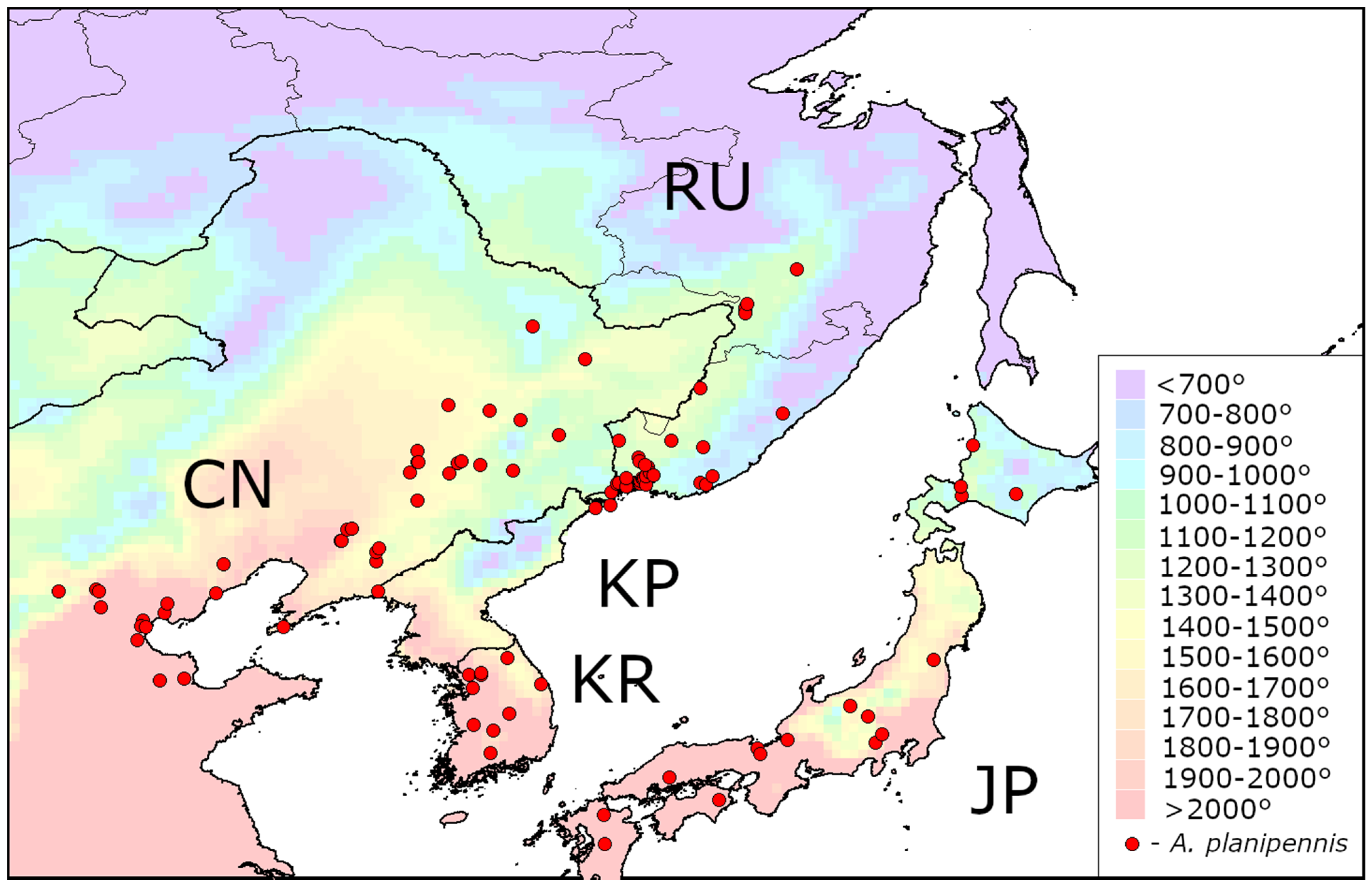
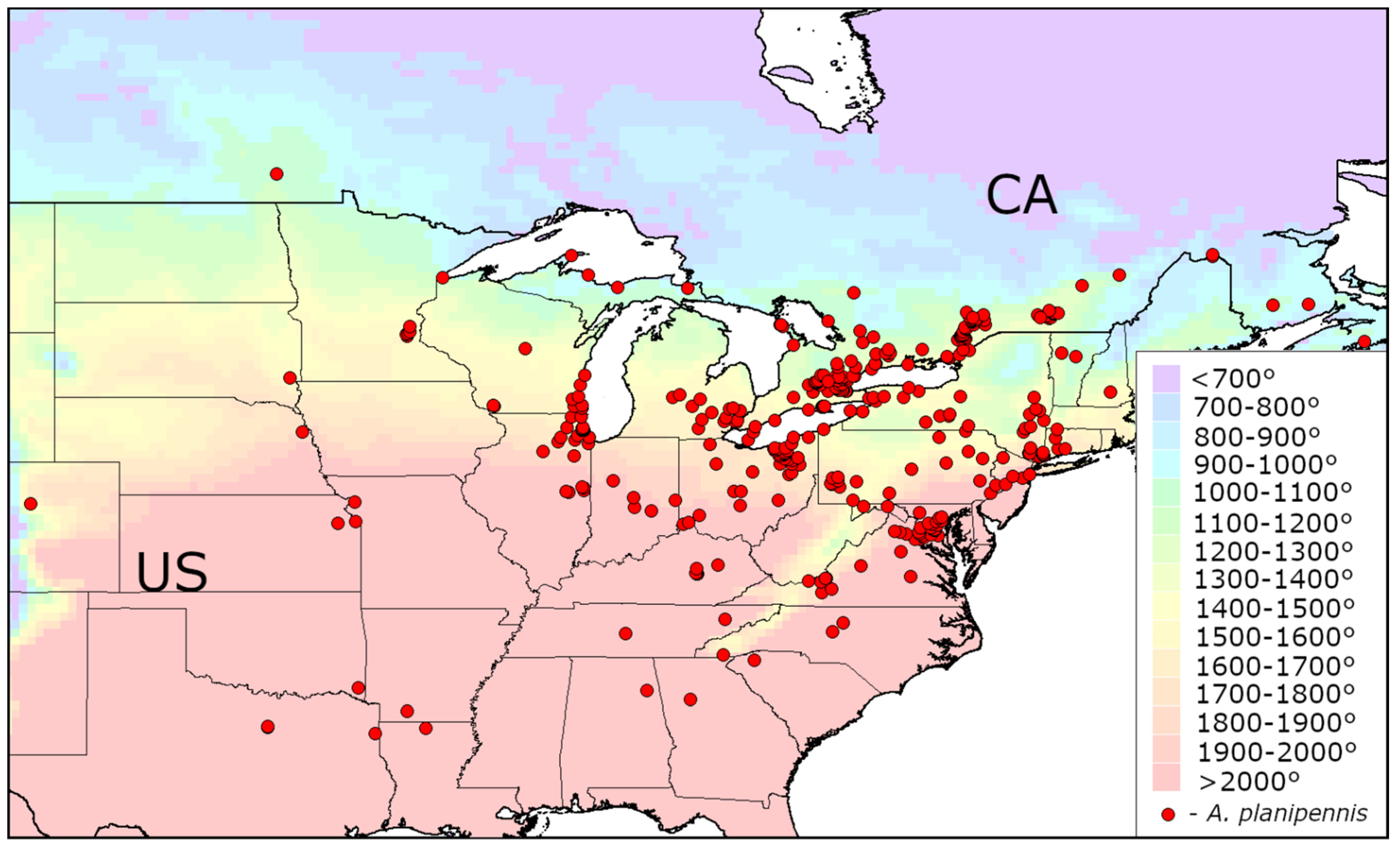
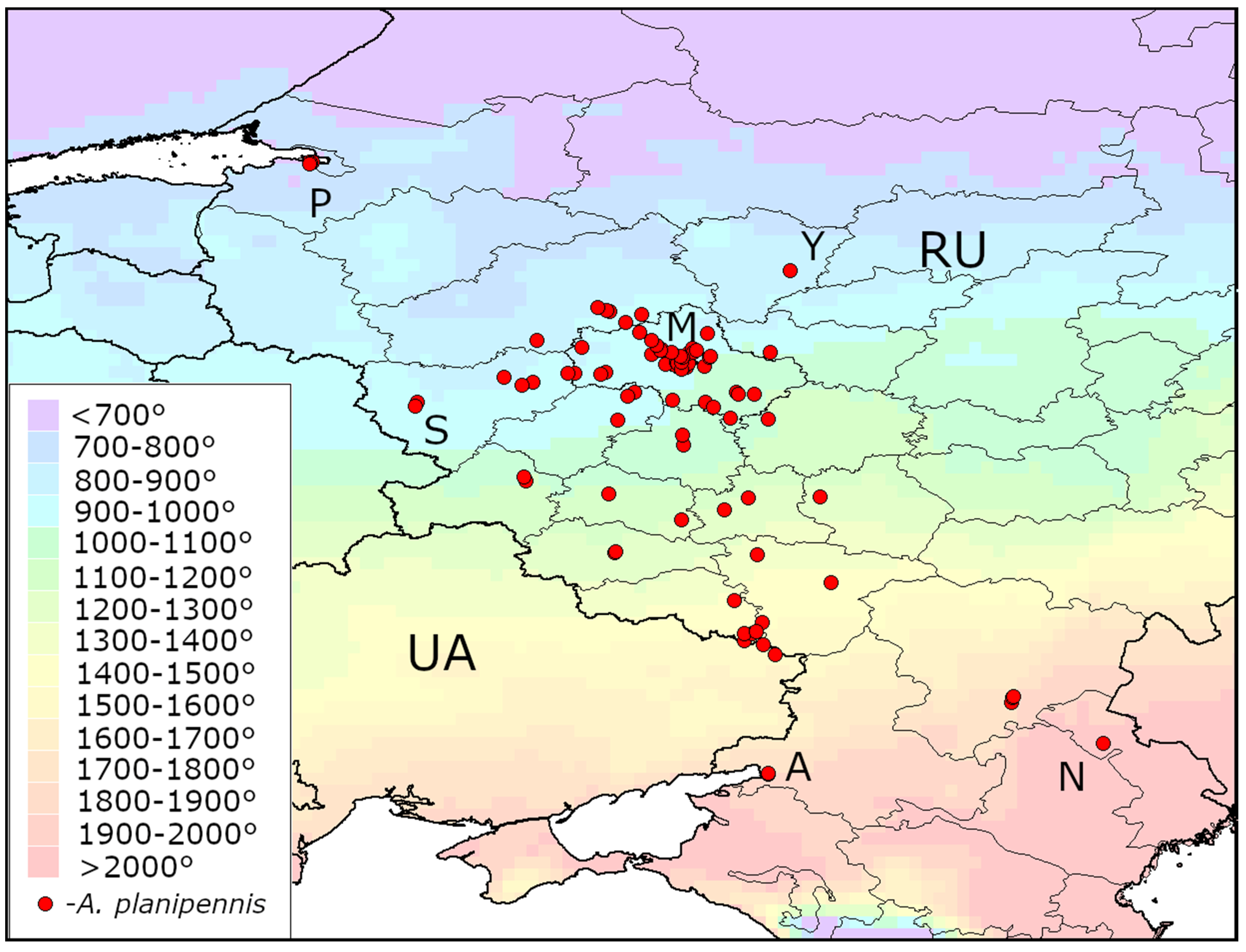

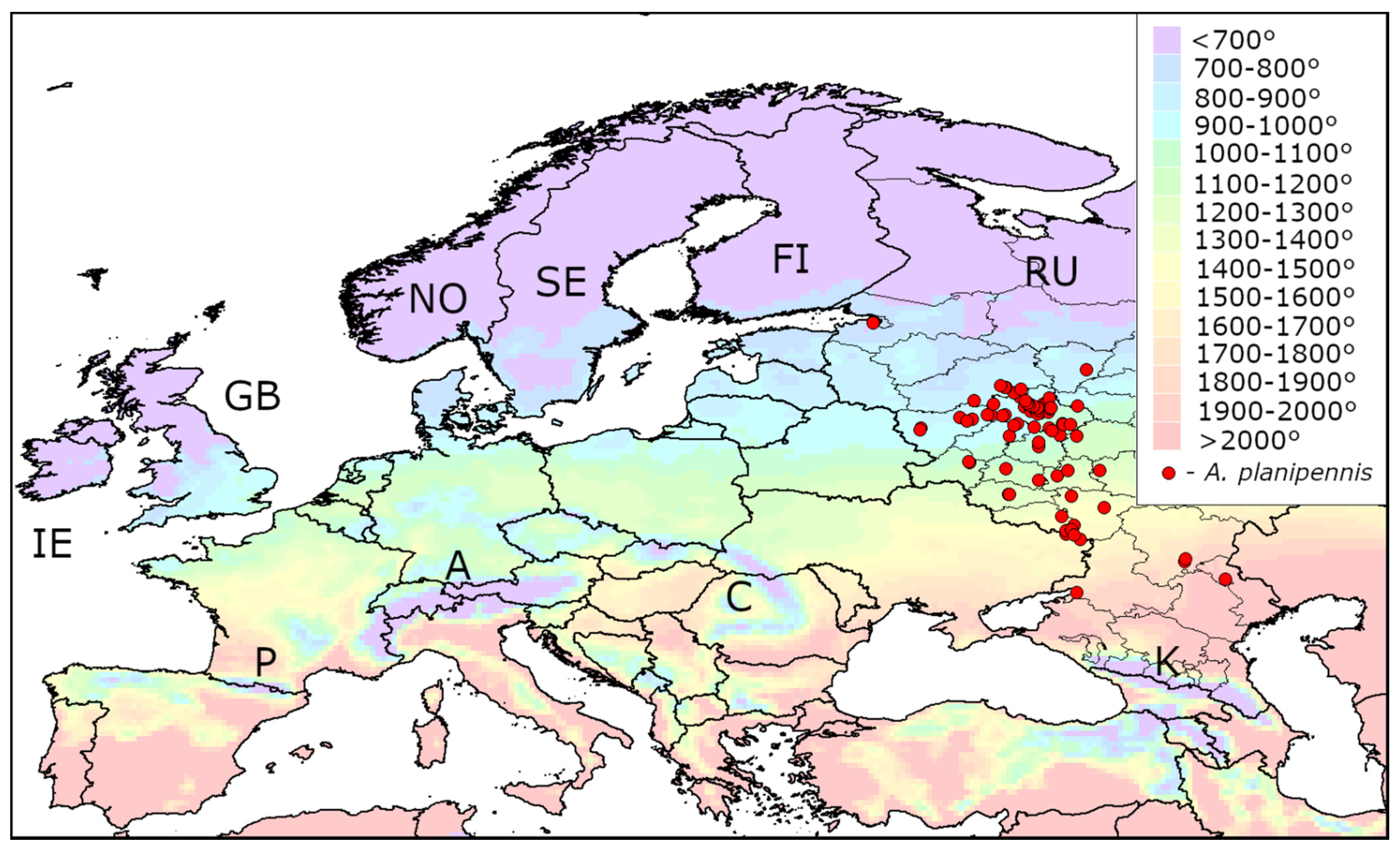
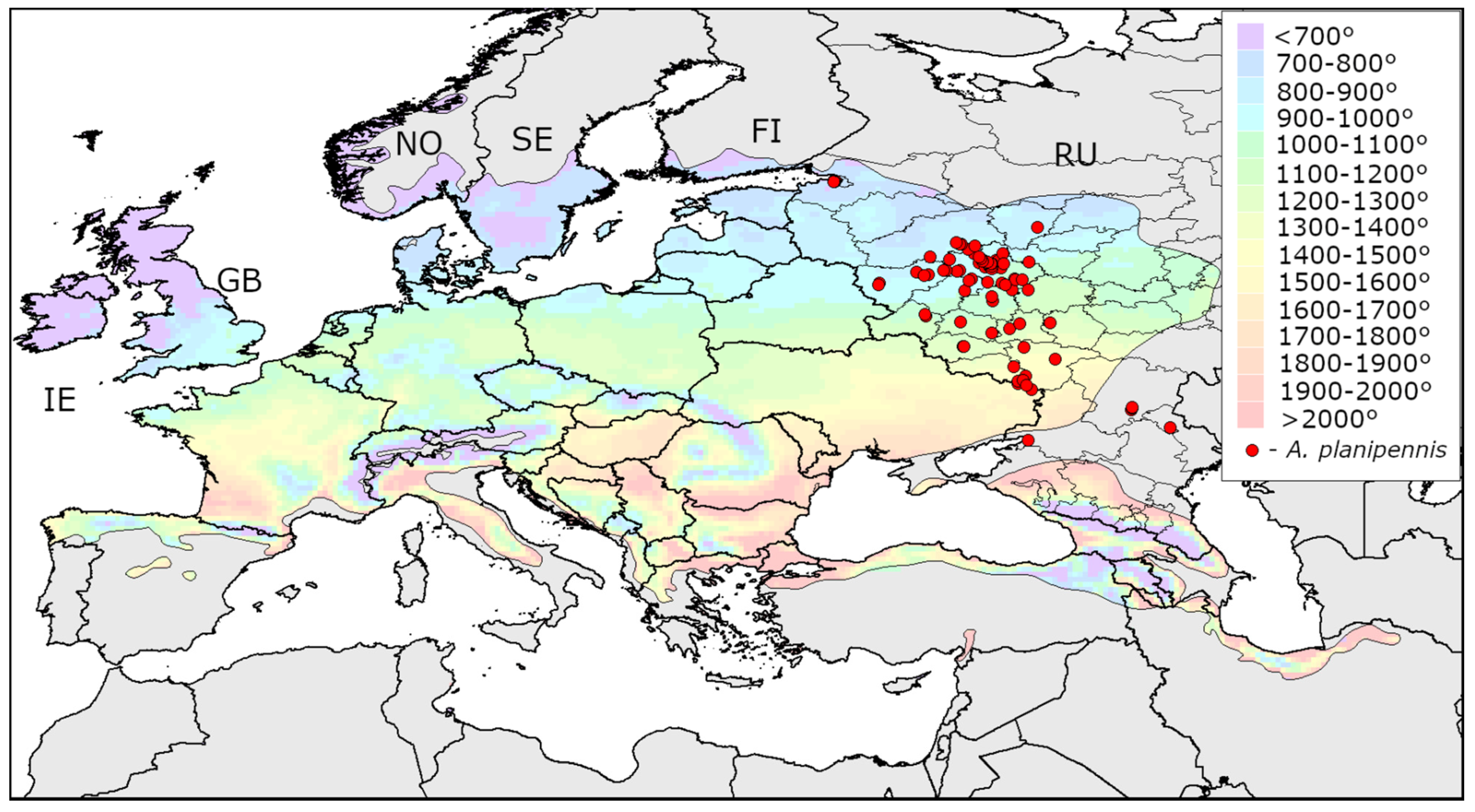
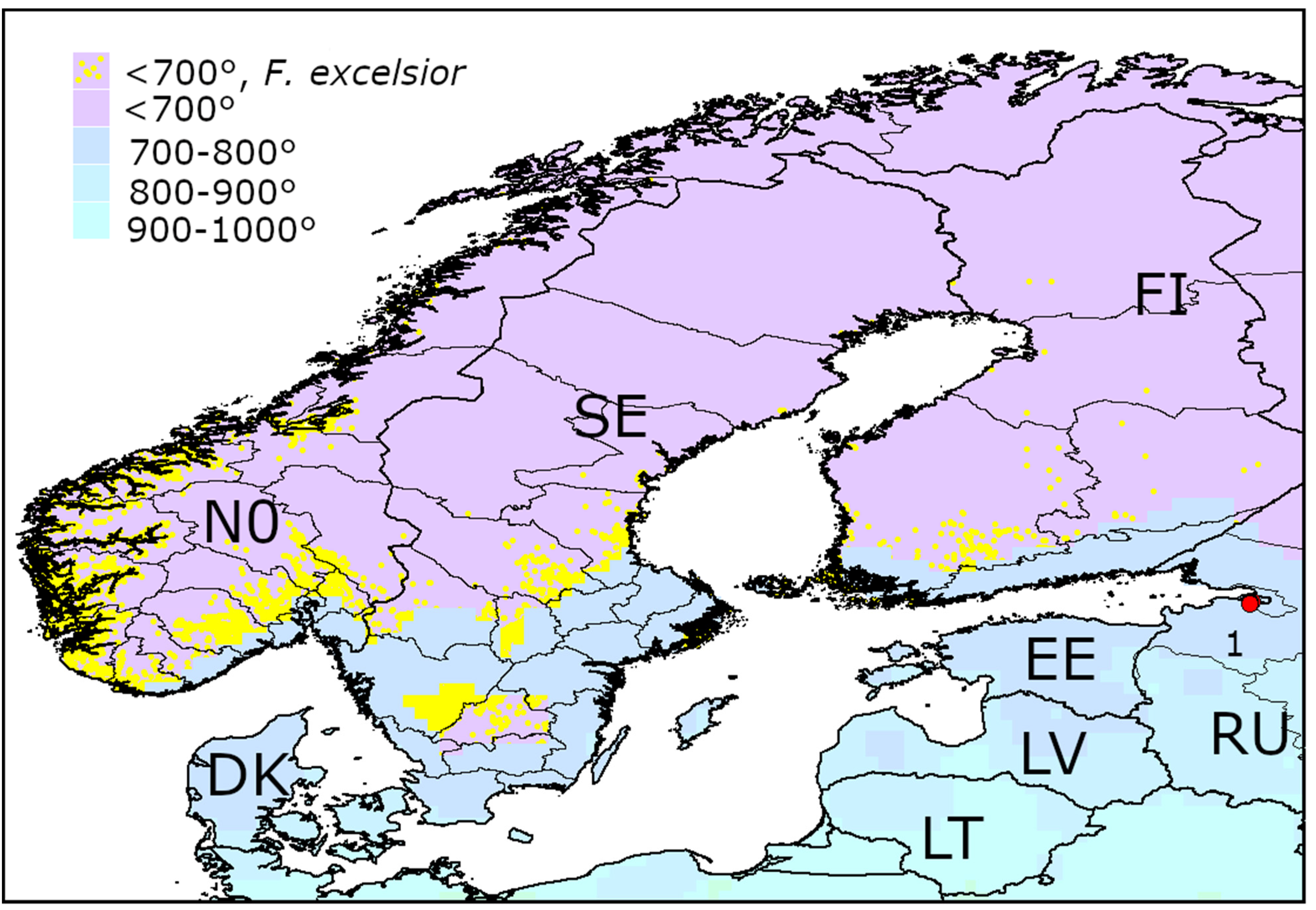
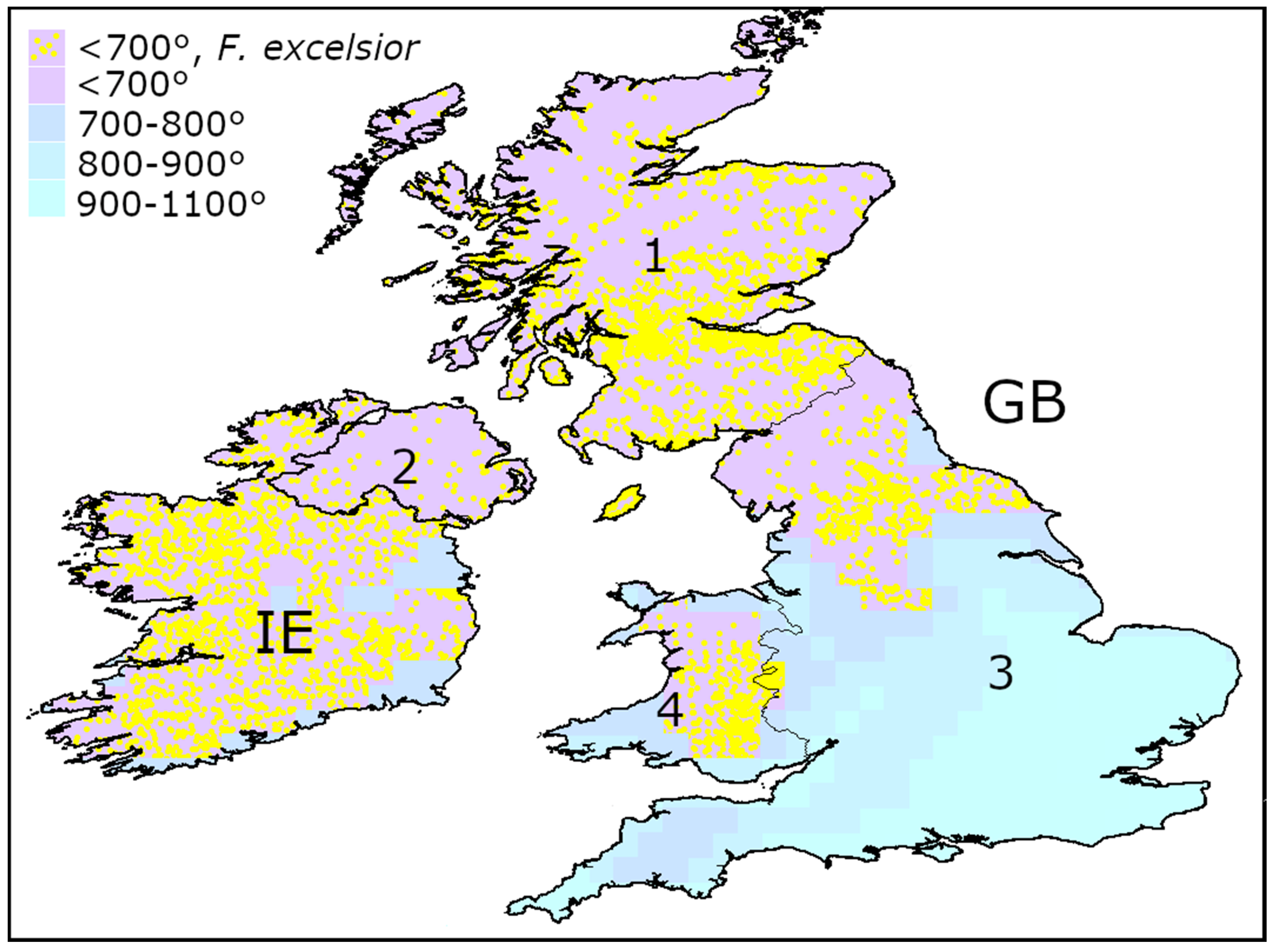
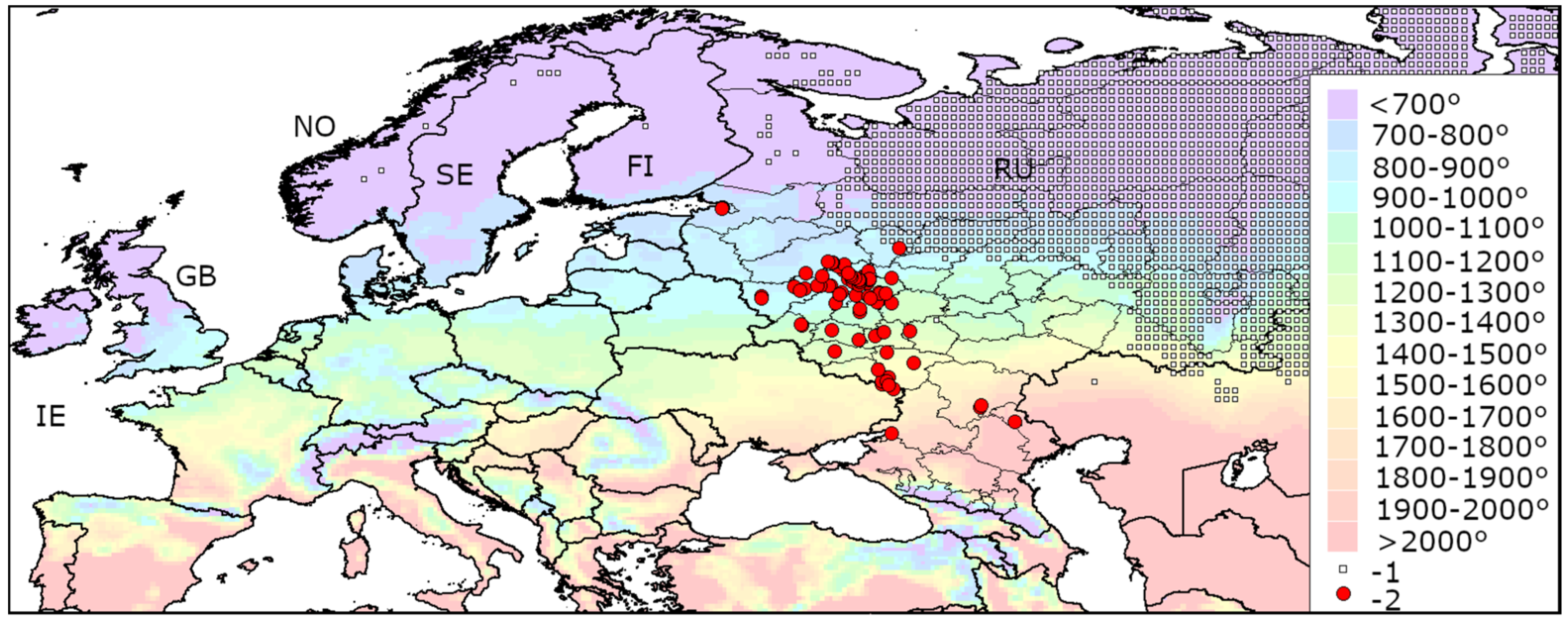
| Continent | Minimum | Maximum |
|---|---|---|
| Asia | 714 | 2778 |
| North America | 705 | 3676 |
| Europe (Russia and Ukraine) | 711 | 2046 |
Publisher’s Note: MDPI stays neutral with regard to jurisdictional claims in published maps and institutional affiliations. |
© 2022 by the authors. Licensee MDPI, Basel, Switzerland. This article is an open access article distributed under the terms and conditions of the Creative Commons Attribution (CC BY) license (https://creativecommons.org/licenses/by/4.0/).
Share and Cite
Orlova-Bienkowskaja, M.J.; Bieńkowski, A.O. Low Heat Availability Could Limit the Potential Spread of the Emerald Ash Borer to Northern Europe (Prognosis Based on Growing Degree Days per Year). Insects 2022, 13, 52. https://doi.org/10.3390/insects13010052
Orlova-Bienkowskaja MJ, Bieńkowski AO. Low Heat Availability Could Limit the Potential Spread of the Emerald Ash Borer to Northern Europe (Prognosis Based on Growing Degree Days per Year). Insects. 2022; 13(1):52. https://doi.org/10.3390/insects13010052
Chicago/Turabian StyleOrlova-Bienkowskaja, Marina J., and Andrzej O. Bieńkowski. 2022. "Low Heat Availability Could Limit the Potential Spread of the Emerald Ash Borer to Northern Europe (Prognosis Based on Growing Degree Days per Year)" Insects 13, no. 1: 52. https://doi.org/10.3390/insects13010052
APA StyleOrlova-Bienkowskaja, M. J., & Bieńkowski, A. O. (2022). Low Heat Availability Could Limit the Potential Spread of the Emerald Ash Borer to Northern Europe (Prognosis Based on Growing Degree Days per Year). Insects, 13(1), 52. https://doi.org/10.3390/insects13010052






